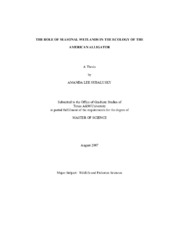| dc.contributor.advisor | Fitzgerald, Lee A. | |
| dc.contributor.advisor | Smith, Lora L. | |
| dc.creator | Subalusky, Amanda Lee | |
| dc.date.accessioned | 2010-01-15T00:00:24Z | |
| dc.date.accessioned | 2010-01-16T02:01:17Z | |
| dc.date.available | 2010-01-15T00:00:24Z | |
| dc.date.available | 2010-01-16T02:01:17Z | |
| dc.date.created | 2007-08 | |
| dc.date.issued | 2009-05-15 | |
| dc.identifier.uri | https://hdl.handle.net/1969.1/ETD-TAMU-1640 | |
| dc.description.abstract | The American alligator (Alligator mississippiensis) has been frequently studied in large reservoirs and coastal marshes. Large ontogenetic shifts in their diet and morphology have been linked with changes in habitat use, with adult males using deep, open water and juveniles and nesting females relying on vegetated marsh. In certain regions of the inland portion of the alligator’s range, these different aquatic habitats are represented by seasonal wetlands and riverine systems that are separated by a terrestrial matrix. Ontogenetic habitat shifts, therefore, would require overland movements between systems, which has important implications for conservation of the species. I tested several commonly used methods of surveying alligator populations to determine the most effective method of studying alligators in seasonal wetlands. I then used systematic trapping, nest surveys and radio telemetry to determine habitat use and overland movement rates by different sex and size classes. I found that seasonal wetlands provided nesting and nursery sites for these inland alligator populations, but that both juveniles undergoing an ontogenetic shift and nesting females move between the wetlands and riverine systems. Overland movements by alligators between the wetland and riverine habitats establish a level of functional connectivity between these aquatic ecosystems. I constructed a habitat suitability index of both the wetlands and the surrounding landscape to determine which patch and landscape characteristics were important to wetland use by alligators. I found that both descriptive wetland characteristics and the spatial relationships between wetlands were important predictors of alligator use. Overland movement was related to upland landuse as well as distance between aquatic habitats. Conserving a variety of wetland sizes and types within an intact upland matrix is critical to maintaining connectivity across the landscape. Furthermore, understanding how species may act as mobile links between ecosystems, particularly those with ontogenetic niche shifts, illustrates the importance of approaching conservation from a landscape perspective. | en |
| dc.format.medium | electronic | en |
| dc.format.mimetype | application/pdf | |
| dc.language.iso | en_US | |
| dc.subject | seasonal wetlands | en |
| dc.subject | American alligator | en |
| dc.subject | double-observer survey | en |
| dc.subject | ontogenetic niche shift | en |
| dc.subject | functional connectivity | en |
| dc.subject | habitat suitability model | en |
| dc.title | The role of seasonal wetlands in the ecology of the American alligator | en |
| dc.type | Book | en |
| dc.type | Thesis | en |
| thesis.degree.department | Wildlife and Fisheries Sciences | en |
| thesis.degree.discipline | Wildlife and Fisheries Sciences | en |
| thesis.degree.grantor | Texas A&M University | en |
| thesis.degree.name | Master of Science | en |
| thesis.degree.level | Masters | en |
| dc.contributor.committeeMember | Winemiller, Kirk O. | |
| dc.contributor.committeeMember | Wu, X. Ben | |
| dc.type.genre | Electronic Thesis | en |
| dc.type.material | text | en |
| dc.format.digitalOrigin | born digital | en |


